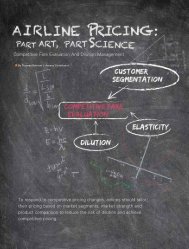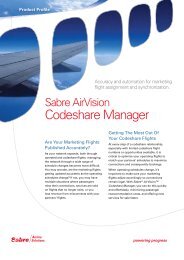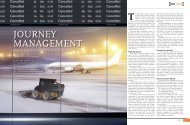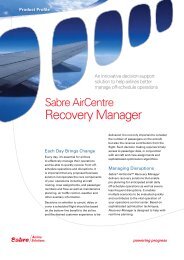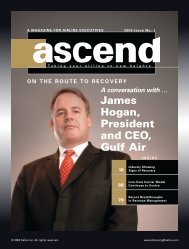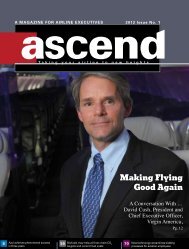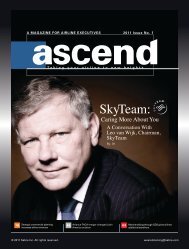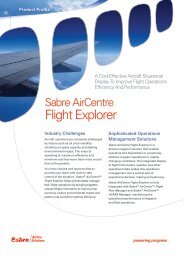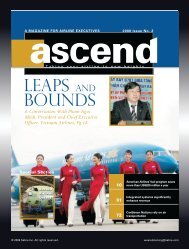2009 Issue 1 - Sabre Airline Solutions
2009 Issue 1 - Sabre Airline Solutions
2009 Issue 1 - Sabre Airline Solutions
Create successful ePaper yourself
Turn your PDF publications into a flip-book with our unique Google optimized e-Paper software.
In November 2007, Virgin Blue<br />
announced an interline deal with international<br />
carrier Garuda Indonesia, offering easy<br />
transfer from a domestic Virgin Blue flight<br />
to an international Garuda service departing<br />
from Australia’s Perth, Melbourne, Sydney<br />
or Darwin.<br />
Most recently, Virgin Blue announced<br />
an interline agreement with Vietnam<br />
<strong>Airline</strong>s, which allows passengers to fly<br />
from Melbourne and Sydney to Ho Chi Minh<br />
City, Vietnam, then transfer easily to any of<br />
the 41 international and 18 domestic destinations<br />
served by Vietnam <strong>Airline</strong>s.<br />
“This agreement with Vietnam <strong>Airline</strong>s<br />
brings the number of Virgin Blue codeshare<br />
and interline agreements to 10,” said Virgin<br />
Blue Chief Executive Officer Brett Godfrey.<br />
“It’s a significant new association as it<br />
means Virgin Blue guests will now have the<br />
option of convenient travel to one of Asia’s<br />
most interesting and popular destinations.<br />
We are pleased to be partnering with a<br />
reputable carrier such as Vietnam <strong>Airline</strong>s,<br />
to offer more choice for leisure and business<br />
travelers.”<br />
AirAsia x<br />
AirAsia, Asia’s largest low-fare, nofrills<br />
airline, pioneered low-cost traveling in<br />
the region. It was also the region’s first airline<br />
to implement fully ticketless travel and<br />
unassigned seats. In January 2007, AirAsia<br />
further demonstrated its pioneer thinking<br />
when it affiliated with AirAsia X (previously<br />
known as FlyAsianXpress), a long-haul, lowcost<br />
carrier to cover destinations more than<br />
four hours in flight duration from Kuala<br />
Lumpur, Malaysia.<br />
A series of strategic investor relationships<br />
has put AirAsia X on solid financial<br />
ground, allowing it to expand beyond its<br />
original Australian Gold Coast Airport destinations.<br />
The carrier has secured rights to<br />
land in China, Korea and west Asia, with<br />
future expansion plans that include India,<br />
the Middle East and Europe. Its European<br />
expansion was confirmed in December<br />
when executives announced the launch of<br />
direct service flights from Kuala Lumpur to<br />
London, which began in March and operates<br />
five times a week.<br />
Network carriers respond<br />
While low-cost carriers are borrowing<br />
some moves from network carrier playbooks,<br />
network carriers are incorporating<br />
some low-cost carrier strategies themselves<br />
in hopes of remaining competitive.<br />
“As we are in a recession that is<br />
becoming worse, there is going to be an<br />
impact on air travel,” said Bruce Zirinsky, a<br />
bankruptcy attorney who spoke to reporters<br />
about the state of the industry last<br />
December. “There is already shrinking<br />
demand and if that continues, it is fair to say<br />
we will see more consolidation.”<br />
Lucrative business from international<br />
business travelers is forcing strong international<br />
alliances.<br />
American <strong>Airline</strong>s lost its status as<br />
the world’s largest airline last year with the<br />
merger of Delta Air Lines and Northwest<br />
<strong>Airline</strong>s. An alliance by rivals United <strong>Airline</strong>s<br />
and Continental <strong>Airline</strong>s is putting additional<br />
pressure on American <strong>Airline</strong>s.<br />
<strong>Airline</strong> economists predict other sizeable<br />
U.S. airlines could possibly make headlines<br />
with mergers this year including US<br />
Airways, Southwest <strong>Airline</strong>s, Northwest<br />
<strong>Airline</strong>s and jetBlue Airways.<br />
Across the pond, merger mania and<br />
low-cost subsidiaries are taking off. British<br />
Airways is in talks with Iberia and has<br />
recently launched its own budget carrier.<br />
Last June, OpenSkies made its inaugural<br />
flight using a single Boeing 757 transferred<br />
from British Airways’ fleet. The flight demonstrated<br />
that British Airways was doing<br />
more than taking advantage of the recent<br />
E.U.-U.S. open-skies agreement. It was testing<br />
a new business model by applying the<br />
low-cost structure of a budget carrier to a<br />
more upscale product.<br />
“Low cost doesn’t mean low fares,”<br />
British Airways Chief Executive Officer Willie<br />
Walsh told reporters. “There is a lower cost<br />
base, but it’s still a premium product.”<br />
OpenSkies is unique in that it combines<br />
the perks of a traditional carrier<br />
— including oneworld membership, more<br />
legroom and electrical outlets — with<br />
slimmed-down staffing levels, fewer<br />
expensive benefits and a chance to simplify<br />
complex operating systems that are<br />
entrenched in flagship carriers. The idea is<br />
to attract budget-minded corporate travelers<br />
who don’t want to give up all of the<br />
amenities of the front cabin.<br />
Iberia is another example of a network<br />
carrier adopting its own budget<br />
airline. In 2006, the Spanish flag carrier<br />
bought an 80 percent stake in Clickair<br />
where it directed all of its short-distance<br />
passengers, except those from its Madrid,<br />
Spain, hub. The airline has been successful,<br />
say experts, because of Clickair’s<br />
efforts to keep Iberia — and its network<br />
mentality — at arm’s length.<br />
In January, the European Commission<br />
gave conditional clearance for closer ties<br />
between Iberia, Clickair and Barcelona,<br />
Spain-based Vueling. Vueling, named in<br />
2006 among Europe’s best low-cost carriers,<br />
started restructuring in 2007 to<br />
enhance profitability. Last July, Vueling<br />
and Clickair announced plans for a full<br />
merger to create a carrier better equipped<br />
to tackle stiff competition and high fuel<br />
costs.<br />
Agreements And It requirements<br />
For an airline, regardless of its business<br />
model or strategic partnerships, it is<br />
just as important to have robust computer<br />
systems as it is to have a modern fleet.<br />
Creating flight schedules, providing fare<br />
information, making reservations, offering<br />
electronic ticketing, effectively managing<br />
passenger check-in, changing a booking<br />
or giving credit for frequent flyer miles are<br />
impossible without sophisticated information<br />
technology.<br />
Today, many airlines have their own IT<br />
systems that are unique to them, even though<br />
tasks are similar. However, when they act in<br />
concert, in an alliance, for example, the use of<br />
different hardware and software by individual<br />
member airlines poses major problems, making<br />
it time consuming, expensive and complex<br />
for them to achieve their common goals.<br />
Regardless of the form an airline agreement<br />
takes — codeshare, alliance, interline<br />
or joint venture — decision makers should<br />
look for synergies in network, business and<br />
systems compatibility to avoid an historically<br />
dismal track record of past airline partnerships.<br />
Network and business compatibility evaluations<br />
are relatively simple when compared to<br />
the complexities of systems integration.<br />
Philip Wang, principal management consultant<br />
for <strong>Sabre</strong> <strong>Airline</strong> <strong>Solutions</strong>, suggests<br />
that before airlines enter into an agreement,<br />
they should evaluate IT compatibility by analyzing<br />
four key operating systems:<br />
1. Reservations and ticketing systems — Do<br />
the systems enable free sell and interline<br />
e-ticketing?<br />
2. Revenue accounting systems — Can they<br />
handle the type of interline billing settlement<br />
that both partners want to use?<br />
3. Check-in systems — Does the check-in system<br />
handle interline through check-in?<br />
4. Web sites — Do both airlines’ Web sites<br />
display, reserve and ticket codeshare flights<br />
and multi-leg interline itineraries on top<br />
travel portals and each partner Web site?<br />
“Without this kind of system compatibility,<br />
the partnership can become very costly in<br />
terms of investment and lost opportunity,”<br />
Wang said. a<br />
Lynne Clark can be contacted at<br />
wearelistening@sabre.com.<br />
ascend 35<br />
industry



